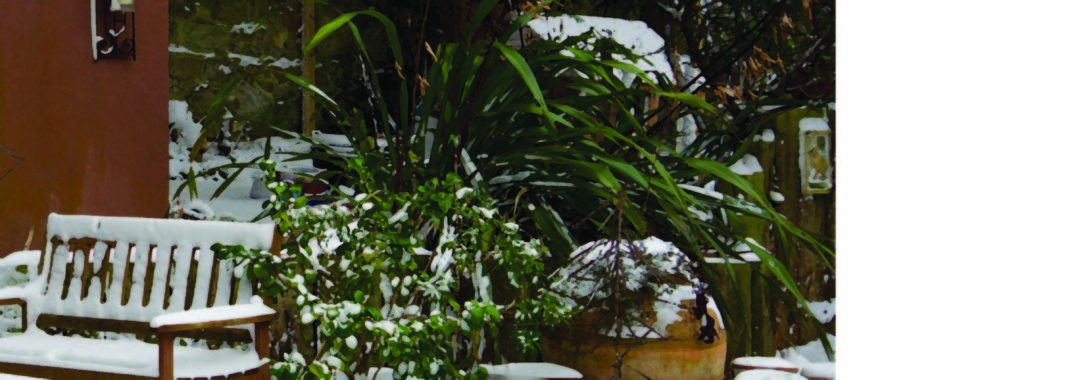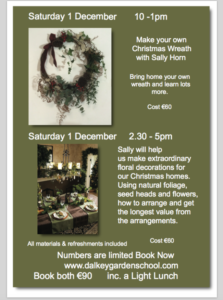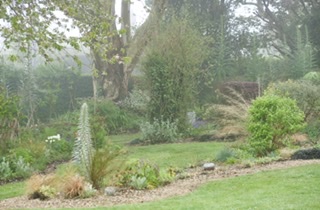The gift of Learning. Gift vouchers can either be posted out or sent via email.
Category Archives: Upcoming Events New
What to Do Now in the Garden October
Top 10 things to do in
your garden now
1 Photograph your garden- it is amazing how we forget.
2 Visit garden centres to see what plants/shrubs are flowering now to fill in gaps
3 Divide large clumps of perennials – we get more plants, free up space and allow for better growth next year.
4 Take hardwood cuttings – this is when this year’s growth has become harder – firmer in other words not soft.
Take care to choose a healthy parent plant free from pests or disease and use a sharp, sterilised secateurs or knife. Careful labelling is key and should include the date the cuttings were taken, along with the name of the parent plant, use a compost 50 / 50 sand in a pot. Plant around the edges of the pot. Also, there can be a low rate of success so take lots. Unlike soft and semi-ripe cuttings, hardwood cuttings do not require bottom heat or a moist atmosphere. If you have space you can also simply dig a slit trench half the height of the cuttings and fill the bottom with sharp sand or grit.
Insert the cuttings vertically, to a third to half of their length and back-fill the soil, firming them in. You can use a hormone rooting powder, but this is generally felt to be unnecessary. Water well and label the cuttings so you know what they are. A cold frame can be placed over the top to encourage faster rooting if required.
Hardwood cuttings are very slow to form roots, so don’t expect them to root fully until at least the next spring. If rooted well the cuttings will sprout strong shoots and grow away.
Ideal shrubs for hardwood cuttings are Buddleia, weigela, privet (Ligustrum), Philadelphus, forsythia and willow, but you can experiment with any woody shrub that takes your fancy. Taking cuttings is free, and if they don’t succeed, no harm will have been done. Others plants eminently suited to being propagated from semi-hardwood cuttings include many shrubby evergreens such as rosemary, sage, lavender, box, escallonia, holly, viburnum, hebe, camellia, ceanothus, cistus and choisya. Good luck.
5 Plant bulbs for spring – wait till November to plant tulips. Think also of indoor bulbs for Christmas such as Hyacinths, plant NOW for Christmas. Narcissi Paper White take 6 weeks from planting to flowering and have an amazing scent to fill your home at Christmas when they are finished flowering plant them out into your garden the same with your Hyacinths.
6 Plan your flower borders for next summer — look at midsummer magazines etc for ideas also include spring as it will help you choose bulbs.
7 Get your leaf pile organised — you can’t buy leaf mould.
8 Trim lawn edges, scarify and repair lawn, use a low nitrogen law feed.
9 Cut your hedges before frosts – pruning at this time of year is for shape.
10 Veg garden plant garlic, onions, broad beans and green manures.
It is very nice to have a neat tidy garden with good structure but don’t forget to leave some areas for all the little creatures to hibernate in – so don’t be too tidy. Leaf and wood piles make great places for hibernation and shelter. I take down my hanging baskets and replace with bird feeders. Birds are essential for our gardens and they do need a helping hand. Containers with water can act as little ponds for frogs and of course sources of drinking water for our little visitors.
There are lots of other jobs to do as well, but try and get as much done now before it gets too cold to venture out.
Sunday, September 30.Gardening Workshop covering the basics.
The garden is now going to sleep, and now is also the time to plan your beautiful garden for next year.
Seed sowing at this time of year can give you a head start on Spring, roots develop and are stronger. Division of plants- making more, moving plants to better positions, planting bulbs for spring and summer. Feeding your soil, protecting it for the weather ahead- drought, are a few of what we will be covering.
Arranging Garden Flowers for Winter Interest
Sunday, October 7 10- 1 pm
Sally Horn florist extraordinaire.
Sally will show us how to use Seed heads, fresh flowers, greenery to make pleasing Winter displays. How to condition your flowers and greenery to get the longest life from them.
If you have a container you would like to use bring it, and we will also have some for you to use also.
All materials will be provided.
Fermented Foods
Fermented Foods
on some of my fliers, the date is wrong Sorry !!!
Saturday 20 October 2018
10am – 1pm
Ever wanted to try making your own fermented food but don’t know where to start? Come along to this demo and learn all about fermenting food and drinks, nature’s probiotics! Learn how to make milk and water Kefir, fermented vegetables, sourdough bread, labneh cheesecake and more. It is a fantastic way to introduce natural probiotics into the body. Walk away with your very own sourdough starter, recipes and a confidence to make them all at home.
Plein Air Oil Painting
Plein Air Oil Painting
25 August 2018
10am – 4pm
Orlagh Murphy
Orlagh Murphy is based in Co Cavan and started concentrating in 2010 on her studio practice after working freelance as an interior decorative artist in the US, Italy, Japan, UK and Ireland. Orlagh now lives in a very rural area of Co Cavan and this has formed the basis for her work to date. The inspiration comes from an area of about 4-8sq kilometres comprising of farmland, river, lake and bogland which surround her home, she also produces work from Sligo, Mayo and West Cork always in a direct response to the seasons. book now
Are Ants Bad for the Garden ?
Are ants in the garden bad?
The good and bad news about ants and plants. Just as a weed is a plant growing in the wrong place, insects in the wrong place are pests.
Ants play a very important role in the ecology of your garden for good and for not so good. …
Ants are predator and prey since they eat the eggs of many insects and serve as food for birds, lizards, and other beneficial. Their tunnels aerate the soil and allow water and nutrients to flow directly to the plant roots. They also distribute seeds by storing them in their tunnels.
The caterpillars of some butterfly groups produce a sweet substance known as honeydew to attract protectors. The ants “farm” the caterpillars, sometimes even carrying them into the ant nests to complete development. This interaction can add more butterflies and birds to your garden as they become attracted to the greater insect activity.
The bad news is that ants can protect honeydew-producing, sucking insects that do a great deal of damage, such as aphids — white, green and black fly also scale and mealybug, populations in the garden.
They actually will drag their eggs into their nests and protect them.
Wasps eat aphids. Aphids produce honeydew which ants love.
Controls of ants in your garden
Planting aromatic herbs around the perimeter of your home can also discourage ants. The added benefit is that other insects and vermin are also put off by the aroma. Any mint plant – mint needs to be planted in a container as it will become too common in your garden, also Tansy and Sage can also be effective repellents.
You can reduce their numbers by pouring boiling hot water on their nests. This technique will help you control population numbers at source.
Ants don’t like citrus. Squeeze a citrus fruit in the direction of your plant so that the juice spritzes out. This should help to repel the ants.
- To make a more heavy-duty citrus repellent, boil the rinds of half a dozen oranges in water for fifteen minutes. Also, you could use citrus drops.
- Blend the rinds and water in a food processor and pour the mixture around your plants.
- Make your own soap solution with 1 teaspoon of liquid dish soap in 1 pint of warm water or you could use washing up liquid diluted
- Spray it on and around your plant. Soaps containing peppermint oil are particularly effective.
Spices such as cinnamon, cloves, chilli powder, coffee grounds, or dried mint tea leaves can be scattered around the base of the plant to deter ants too.
Spray the flying ants ( which are mature mating creatures) with dishwashing soap
Diluted dishwashing soap is an effective agent against flying ants as it attaches to their bodies and dehydrates them.
Get yourself a spray bottle to catch the little creatures in flight and mix two generous squirts of dishwashing liquid with water. This is also effective on aphids on your plants. My mother would have used the water from the basin of washing up water to do this.
Using pesticides can damage beneficial insects and also the balance in your garden is really important to allow nature to do its job.
Botanical Plaster Casting Workshop Saturday 23 June
Botanical Plaster casting with Dee Crofts. Saturday 23 June 10 – 4 pm
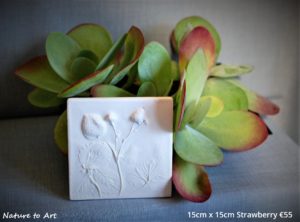
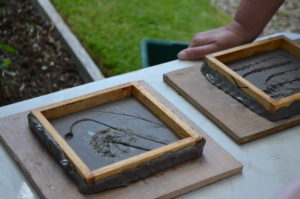
We ran this workshop twice last summer and the response to not only learning and creating a unique piece of art was fantastic. Lunch is included in this workshop.
Again all materials are included. We ran this workshop last year and we had a fantastic day creating plaques and learning in a very social and enjoyable way.
June workshops
We learn through fun and it is an opportunity for friends to do something creative together as are all these workshops.
Botanical Mono Printing with Dee Crofts Saturday, June 9 10 – 1 pm
This will be a unique experience allowing you to use nature as your inspiration to produce prints on fabric. All materials are included and you will not only learn, you will have a print to hold onto forevermore. This is a first time this workshop has been run and judging by others is a must.
Art in the Garden(drawing) with Mairead Byrne on Sunday 10 June from 10 -1 pm
Mairead is a talented artist and teacher and she will guide you on drawing technique while using the garden as your inspiration.
Arranging Garden Flowers with Sally Horn on Saturday 16 June (Blooms Day)
2-5pm.
Sally is an experienced artist in flowers. She will share her creative techniques with you and encourage you with the same. We will be using flowers and greenery from the garden, if you have a special vase you would like to us bring it with you
Botanical Plaster casting with Dee Crofts. Saturday 23 June 10 – 4 pm
We ran this workshop twice last summer and the response to not only learning and creating a unique piece of art was fantastic. Lunch is included in this workshop.
Again all materials are included.

